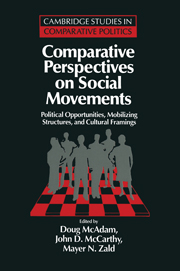 Comparative Perspectives on Social Movements
Comparative Perspectives on Social Movements Book contents
- Frontmatter
- Contents
- Biographical sketches of contributors
- Preface
- Introduction: Opportunities, mobilizing structures, and framing processes – toward a synthetic, comparative perspective on social movements
- PART I POLITICAL OPPORTUNITIES
- PART II MOBILIZING STRUCTURES
- PART III FRAMING PROCESSES
- 11 Culture, ideology, and strategic framing
- 12 Framing political opportunity
- 13 Accessing public, media, electoral, and governmental agendas
- 14 Media discourse, movement publicity, and the generation of collective action frames: Theoretical and empirical exercises in meaning construction
- 15 The framing function of movement tactics: Strategic dramaturgy in the American civil rights movement
- Notes
- References
- Index
12 - Framing political opportunity
Published online by Cambridge University Press: 05 June 2012
- Frontmatter
- Contents
- Biographical sketches of contributors
- Preface
- Introduction: Opportunities, mobilizing structures, and framing processes – toward a synthetic, comparative perspective on social movements
- PART I POLITICAL OPPORTUNITIES
- PART II MOBILIZING STRUCTURES
- PART III FRAMING PROCESSES
- 11 Culture, ideology, and strategic framing
- 12 Framing political opportunity
- 13 Accessing public, media, electoral, and governmental agendas
- 14 Media discourse, movement publicity, and the generation of collective action frames: Theoretical and empirical exercises in meaning construction
- 15 The framing function of movement tactics: Strategic dramaturgy in the American civil rights movement
- Notes
- References
- Index
Summary
The concept of political opportunity structure is in trouble, in danger of becoming a sponge that soaks up virtually every aspect of the social movement environment – political institutions and culture, crises of various sorts, political alliances, and policy shifts. As Tarrow notes (1988: 430), “Political opportunity may be discerned along so many directions and in so many ways that it is less a variable than a cluster of variables – some more readily observable than others.” It threatens to become an all-encompassing fudge factor for all the conditions and circumstances that form the context for collective action. Used to explain so much, it may ultimately explain nothing at all.
Part of the problem is that analysts use political opportunity structure to serve a wide variety of functions, and define it accordingly. Scholars who want to explain the emergence and influence of a movement over time use it as a set of independent variables, to describe dynamic aspects of the political environment that change to allow or encourage the emergence of challengers (e.g., Jenkins and Perrow 1977; McAdam 1982; Meyer 1990, 1993a). Others who want to compare the development of similar movements in different nations, states, or cities use political opportunity structure as a holder for intervening variables such as institutional structures or rules of representation (e.g., Amenta and Zylan 1991; Eisinger 1973; Kitschelt 1986; Tilly 1978).
- Type
- Chapter
- Information
- Comparative Perspectives on Social MovementsPolitical Opportunities, Mobilizing Structures, and Cultural Framings, pp. 275 - 290Publisher: Cambridge University PressPrint publication year: 1996
- 504
- Cited by


